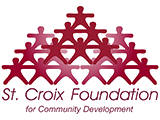Over the last 24 years, St. Croix Foundation has learned some important lessons about effective philanthropy and how to best serve our community. More than just a grantmaker, we have grown skillful at identifying resources and building private-public partnerships to address the root causes to the problems we face. Today, in this era of fewer resources, we are also acutely aware of the need to prioritize investments and leverage scarce resources particularly for our struggling public schools. As our public sector reaches out to the private sector to fill funding gaps, with policies like mandatory EDC education “donations”, we believe that fidelity and accountability for the use of these funds is critical.
Our first lesson brokering partnerships between donors and our schools came many years ago when a generous EDC firm agreed to adopt one of our local high schools. We spent hours touring the campus and meeting with administrators to identify the most urgent needs. When all was said and done, the school pleaded and the donor conceded to repair bathrooms! Despite the vast academic needs of students and teachers at the school, we agreed to use those precious donor dollars to gut and retrofit one bathroom, to make it compliant with the Americans with Disabilities Act, and to repair and paint 13 other bathrooms.
We expended more than $25,000 that we believed could have been leveraged several times over and in turn relieved the government of its obligatory responsibility to address basic infrastructure needs in our schools. While we were pleased to learn that the project had resolved the issue of handicap accessibility, which contributed to the school’s full accreditation, the experience taught the Foundation some profound lessons that have since informed how we guide and advise donors who are interested in providing resources and other supports to our public schools.
In fact, we may be one of a few non-profits in the Territory that consistently steers donors away from projects which we believe will not have lasting impact or the level of accountability necessary for success. We feel too strongly about the urgency of the most critical, instructional-based needs in our public schools and the importance of synergy in how private sector resources are used to address them.
What’s been interesting to us is that oftentimes when people in our community discuss our public schools, the conversation usually centers around the poor physical condition of our schools instead of focusing on reading scores or professional development for teachers. But, little of our research or our experiences point to infrastructure as a significant inhibitor to student achievement. According to the Alliance for Excellent Education’s 2008 report, How Does the United States Stack Up?, “In some of the countries that are now surpassing the U.S. in academic performance, students don’t have even a fraction of the basic resources and amenities we take for granted!”
Following our “bathroom” experience, we launched our Model School Initiative (MSI) fully expecting to find significant infrastructure and resource deficiencies at our pilot school. Instead, what we found was quite to the contrary. Not only were there computers and white boards, along with a host of other technological resources, but we also found many of the same academic programs that were in use at some of the highest-performing stateside schools we had researched. In direct refutation of what we’d heard “on the street,” we learned that the Department of Education had indeed been equipping teachers and administrators with high-quality instructional resources and had dedicated significant funding toward teacher training in the utility of these programs. But there was a catch: while some proven resources had been procured for our schools, we found examples of poor follow-through in ensuring that those resources were actually being effectively implemented, institutionalized and evaluated.
We actually experienced this first-hand during the course of our MSI. After realizing that the scattered computer resources at our pilot school made it impossible to test an entire class, we reached out to Hovensa. They responded in a big way, donating a state of the art technology center, with 30 flat screen computers, desks, commercial air conditioning, and new room enclosures at a cost of over $125,000. The Foundation donated a new security system and paid for monitoring to protect Hovensa’s costly investment. Our partnership with Hovensa was a perfect example of our strategy: brokering strategic private-public partnerships, leveraging scarce funding in order to provide students with the high-quality educational resources they need to be globally competitive.
We hope that the lessons we’ve learned serve to guide stakeholders in building effective, high- impact partnerships that create bridges to success for our schools and our students. We also hope that our elected officials and policy makers will promote private-public partnerships that are based on substantiated need, a fully articulated plan of action, accountability and transparency.
This editorial is part of the Foundation’s Education First series. For more information, call 773.9898.
